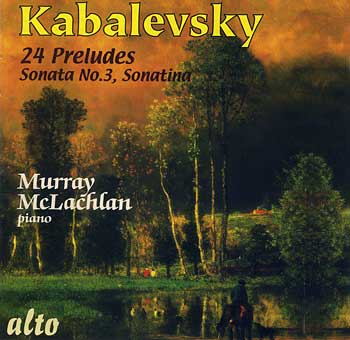Kabalevsky: 24 Preludes
24 Preludes, Op.38 (1343)
[1) No.linCmajor,Andantino 1:30
[2) No.2 in A minor. Scherzando 0:39
[3] No.3 in G major. Vivace leggiero 1:26
[4] No.4 in E minor. Andantino 2:09
[5) No.5 in D major, Andante sostenuto 2:26
[6] No.6 in B minor. Allegro molto 1:15
[7j No.7 in A major, Moderato e tranqillo 3:10
[8j No.8 in F sharp minor, Andante non troppo 2:31
[9] No.9 in F major, Allegretto scherzando 1:20
[10] No.10 in C sharp minor, Non troppo allegro ma agitato 3:03
[11] No.11 in B major, Vivace scherzando 0:56
[12] No.12 in G sharp minor. Adagio 3:16
[13] No.13 in F sharp minor. Allegro non troppo 3:14
[14] No.14 in B flat minor, Prestissimopossibile 2:17
[15] No.15 in D flat major, Allegro marcato 0:54
[16] No.16 in B flat minor, Allegro tenebroso 2:09
[17j No.17 inAflat major, Andante tranquilla 2:30
[18] No.18 in F minor, Largamente con gravitâ 1:29
[19j No.19 in B flat major, Allegretto 0:54
[201 No.20 in C minor. Andantino semplice 2:26
[21] No.21 in B flat major, Festivamente (non troppo allegro) 1:46
[22) No.22 in G minor, Scherzando (non troppo allegro) 1:58
[23] No.23 in F major, Andante sostenuto 1:51
[24] No.24 in D minor, Allegroferoce 4:33
Sonatina in C major, Op.13 No.1 (1930)
[25j I Allegro assai e lusingando 2:17
[26) II Andantino 3:09
[27j III Presto 1:51
Sonata No.3, Op 46 (1945)
[28] I Allegro con moto 4:58
[29) II Andante cantabile 4:52
[30] III Allegro giocoso 4:34
About
On listening to Dimitri Kabalevsky’s (1904-87) 24 Preludes for the first time it is hard to believe that the cycle has remained relatively unknown. Here surely is a major contribution to the piano literature with immediate and popular appeal. Its language is direct yet memorable whilst the difficulties it places on interpreters from the point of view of pianism and colour make it a challenge performers would surely be unwilling to resist! The work is similar to Chopin’s famous cycle, Op.28, in that it contains a prelude in every key (arranged through the cycle of fifths in relative major and minor pairs) but is entirely different in that each piece stems from a folk-song. Most of the folk material was taken from Rimsky-Korsakov’s collection and Alexei Skavronsky has written: ‘It was in itself highly symbolic that in those strenuous war years Kabalevsky should turn to this life-giving spring, drawing from it inspiration and strength. With the intuition of a true artist, Kabalevsky penetrates into the very essence of a folk-melody, revealing its latent idealogical and emotional core and, in this way, creating poetic miniatures filled with profound psychological content.’
Kabalevsky’s emotional, imaginative and technical powers were obviously working in overdrive through the inspiration received from the folk material, and one can but marvel at the ingenious way in which the traditional melodies are incorporated into the compositions, revealing Kabalevsky as a contrapuntal master in the movements which seem like chorale preludes, and an expert in the handling of harmonic pun and ambiguity in the slower preludes where attraction is built up from a latent tonal ambivalence in the folk tune. The craftsmanship and idiomatic pianistic sense present throughout the work are hallmarks of Kabalevsky’s art which one notes in all of his compositions; but above all the sheer range of colour and emotion of the composer’s most significant contribution to the pianoforte literature are exceptional. The preludes were dedicated to the composer’s teacher Myaskovsky, and prefaced with a quotation from Lermontov: ‘If I want to inject the folk element into writing, there is truly no place for me to seek it other than in Russian songs.’
Throughout the cycle, Kabalevsky’s distinctive personality remains intact and though each prelude is different, a sense of unity and ‘oneness’ makes one reluctant to perform individual preludes alone away from the cycle as a whole. Broadly speaking the preludes fall into four group headings:(a) Reflective (Nos.1, 7, 8, 13, 17, 20, 23) (b) Light-hearted (Nos.2, 9, 1 1, 15, 19, 22) (c) Monumental! chorale prelude (Nos.3, 5, 18, 21 (d) Character/mood sketches (Nos.4, 10, 12, 16) with Nos. 6 and 14 remaining as bravura etudes and the final prelude standing alone as a symphonic poem for solo piano.

